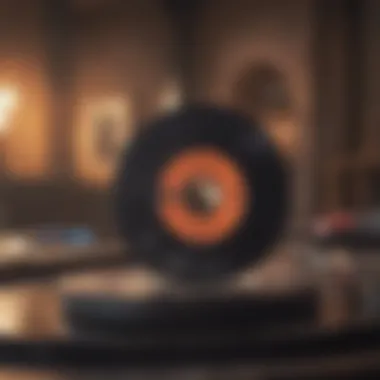Navigating the Labyrinth of Love: Life and Music


Intro
Love is a concept that stretches beyond simple definitions. It fuels passions, propels creativity, and influences our everyday interactions. In music, love is often a staple theme, reflecting the myriad of emotions that individuals experience in their romantic lives. This article examines the intricate relationship between love, life, and music. By analyzing artist profiles and delving into song analysis, we seek to uncover how personal experiences shape music across various genres.
Through this exploration, we will engage with the historical perspectives on love in music, the psychological dimensions of romantic relationships, and how artists articulate these sentiments through their work. The discussions aim to encourage appreciation of how deeply personal emotions resonate in a cultural context.
The narrative will unfold by first examining distinct artists and their backgrounds, followed by a thorough investigation of specific songs that encapsulate the complexities of love. This detailed approach offers insights relevant to music enthusiasts and aspiring musicians alike.
Artist Profile
Biography and Background
Love as a theme in music often reflects the artist's own experiences. Many artists draw from their lives, shaping their narratives into sound. For instance, consider Adele, whose poignant ballads explore themes of heartbreak and longing. Born in Tottenham, London, Adele's upbringing was marked by her rich musical influences. She grew up listening to an array of genres, including soul and R&B, which colored her songwriting style.
Major Influences and Inspirations
Adele’s inspiration stretches from the likes of Etta James to contemporary figures such as Beyoncé. Each of these influences contributes various elements to her music. Etta James’ emotive power is apparent in Adele’s vocals. Similarly, Beyoncé’s blend of personal and political themes resonates within Adele’s compositions. These ties show how love—both its joys and its frustrations—remains a universal aspect of the human experience, articulated through personal stories.
Song Analysis
Theme and Lyrics Breakdown
In examining specific songs, we delve deeper into how romantic relationships are portrayed. Adele's “Someone Like You” exemplifies a narrative steeped in longing and acceptance. The lyrics tell a story of recovery after a significant loss. The emotional weight of these words captures the essence of love lost and the bittersweet nature of moving on.
- Key themes include:
- Heartbreak
- Nostalgia
- Acceptance
Instrumentation and Composition
The composition of “Someone Like You” plays a vital role in conveying emotion. The minimalist piano accompaniment allows Adele's powerful voice to take center stage, drawing listeners into the sentiment of the song. The clarity of the arrangement highlights the lyrical content, fostering an intimate atmosphere without distraction. This dedication to simplicity exemplifies how instrumentation can enhance thematic expression.
"Music can express feelings that are often too complex for words."
Through this analysis, we gain valuable insight into how music serves as a vehicle for expressing love's multifaceted experience. This journey through artist profiles and song analysis creates a comprehensive understanding of the connections between love, life, and music.
Understanding Love: A Psychological Perspective
Understanding the concept of love is crucial when examining its role in both life and music. This section seeks to illuminate the psychological underpinnings of love, guiding the reader through various theories and definitions that encapsulate the complexities of this emotion. Pondering love aids in grasping personal experiences and the factors that influence how relationships evolve over time.
Defining Love
Defining love is not a straightforward task. It encompasses a variety of emotions, ranging from affection to infatuation, and can manifest in several ways. Love can be romantic, platonic, familial, or even self-directed. Each type comes with its own set of characteristics that shape human interactions. By establishing clear definitions, we create a foundation for analyzing how love influences music and, ultimately, our lives.
Theories of Love
Understanding the various theories of love adds depth to the discussion. These frameworks provide insights and vocabulary to dissect personal feelings and societal influences.
Attachment Theory
Attachment Theory is a well-studied psychological model that discusses how early relationships with caregivers shape interpersonal connections later in life. This theory asserts that secure, anxious, or avoidant styles of attachment can significantly dictate an individual’s romantic behaviors.
The key characteristic of Attachment Theory lies in its focus on the bond between individuals, resulting in different modes of relating to others based on formative experiences. It is a popular choice for this article due to its broad relevance in analyzing relationship dynamics.
In terms of advantages, understanding one's attachment style can foster better communication and strengthen bond between partners. However, it may lead to oversimplifications when applied broadly.
Sternberg's Triangular Theory


Sternberg's Triangular Theory of Love presents love as a composition of three essential elements: intimacy, passion, and commitment. The balance of these elements determines the nature of the relationship.
This theory is beneficial for the discussion, as it breaks down love into comprehensible components that affect relationships distinctly. The unique feature of this approach is the notion that relationships can evolve based on the interplay of these three dimensions over time.
However, it also has its disadvantages. Reducing love to just three factors might overlook the nuanced experiences many individuals encounter in their journey of love.
Different Types of Love
Acknowledging Different Types of Love helps in categorizing emotional experiences. This perspective encompasses romantic love, platonic love, familial love, and self-love, each carrying its own significance.
The essential characteristic of this classification is the diversity of emotional experiences recognized under love. By exploring these types, we understand better how each contributes uniquely to personal growth and artistic expression.
One advantage of identifying different forms of love is the appreciation of emotional richness in life. Yet, defining love can sometimes feel limiting when one considers the blend of various emotional experiences individuals may face.
The Role of Emotion in Relationships
Emotion serves as the cornerstone of relationships. It plays a role in how individuals connect, empathize, and interact with one another. Understanding the emotional layers helps decipher conflicts, joys, and the overall tapestry of relationships. This aspect solidifies the connection between love and music. Many songs tap into emotions felt in relationships, reflecting joy, sadness, or longing. This reciprocal relationship enables a profound exploration of the human experience through sound and lyrics.
"Music can express that which cannot be put into words and that which cannot remain silent."
In exploring these intricate aspects, this section sets the stage for deeper discussions on how cultural expressions and personal narratives intertwine with love and music.
Cultural Expressions of Love in Music
The emotional connection between love and music is both universal and profound. Music acts as a vessel for expressing sentiments that often elude words. It encapsulates the highs of romance, the lows of heartbreak, and the intricate shades in between. Understanding cultural expressions of love in music allows us to appreciate this dynamic interaction that shapes both personal experiences and broader societal norms. Different cultures, eras, and genres reveal how love influences artistic creation, providing insights into the human experience.
Historical Context of Love Songs
The roots of love songs can be traced back to ancient cultures. From the troubadours of medieval Europe to traditional ballads, love has always inspired musicians. These early forms laid the groundwork for contemporary expressions in music. The evolution of love songs reflects societal changes in attitudes towards romance, from courtly love to modern concepts of equality and personal choice. Analyzing historical texts reveals how relationships have been celebrated or critiqued through musical narratives across time.
Genres that Define Love
In examining love in music, certain genres stand out due to their distinctive ways of expressing romantic themes.
Pop
Pop music is characterized by its catchy melodies and broad appeal. It often deals with themes of young love, infatuation, and heartbreak. The simplicity of pop lyrics makes them accessible, enhancing their connection with a wide audience. Notable pop artists like Taylor Swift and Ed Sheeran tackle love in a relatable manner, allowing listeners to see themselves in the songs. The genre's repetitive structures provide a comforting familiarity, but this can sometimes limit the depth of exploration into complex emotional landscapes.
R&B
R&B focuses on emotive vocal performances and smooth rhythms. It historically addresses love with a deeper intensity. Artists like Marvin Gaye and Alicia Keys have produced timeless songs that explore both the joys and pains of love. The genre's ability to blend soulful melodies with heartfelt lyrics resonates, making it a powerful medium for expressing vulnerability. However, the focus on romantic themes may reinforce certain stereotypes about relationships.
Rock
Rock music presents a raw and often rebellious take on love. From the passionate declarations of classic rock anthems to the angst of alternative rock, this genre captures a diverse spectrum of romantic experiences. Bands like The Beatles and Nirvana have left a significant impact, showcasing love's transformative and sometimes tumultuous nature. The energy and emotion conveyed through guitars and drums can create a visceral connection, but this expression might veer into hyperbole, risking authenticity.
Country
Country music often portrays love as intertwined with storytelling. Artists like Dolly Parton and Johnny Cash weave narratives that highlight everyday romance and the heartache that comes with it. The genre gains its strength from its relatability, as it often speaks to life experiences that listeners recognize. A common feature of country songs is a focus on familial and community dynamics in relationships. However, some may view country love songs as overly simplistic or formulaic due to recurring themes.
Influential Artists and Their Impact
Certain artists have defined the sound and influence of love in music, creating songs that resonate across generations.
Greatest Love Songs of All Time
The greatest love songs are celebrated for their lyrical and musical brilliance. Songs like "I Will Always Love You" by Whitney Houston or "Something" by The Beatles encapsulate emotions that are often hard to articulate. These tracks have transcended time, maintaining relevance through various cultural shifts. Their unique elements, such as strong melodies and poignant narratives, make them timeless pieces. However, sometimes the hype around such songs can overshadow emerging artists exploring new themes.


Modern Contributions
In recent years, modern artists continue to redefine love in their work. With the evolution of technology and social media, their expressions reflect contemporary relationships. Artists like Billie Eilish explore themes of uncertainty and vulnerability, breaking traditional molds of love narratives. The impact of modern contributions is significant, as they offer fresh perspectives but may lack the emotional depth that characterized earlier works.
Cross-Cultural Influences
The influence of different cultures adds rich layers to the expression of love in music. Genres such as Reggae or Afrobeat bring unique rhythms and stories of love. Artists like Bob Marley have spread messages of love and unity, transcending geographical boundaries. This cross-cultural fusion enriches the global music landscape and encourages a more inclusive understanding of love. Despite their advantages, this blending can sometimes lead to misunderstandings of cultural nuances.
The Evolution of Love Themes in Music
The exploration of love themes in music is crucial for understanding how our emotions are articulated and transformed through art. This section examines the progression of love representations, tracing their development from classical roots to contemporary interpretations. Love songs have served not only as a reflection of personal feelings but also as a societal mirror, showing how cultures and eras perceive this multifaceted emotion.
From Classical to Contemporary
Historically, love was often depicted in classical music through operas, symphonies, and vocal compositions. Composers like Wolfgang Amadeus Mozart and Giuseppe Verdi conveyed deep emotional narratives through their scores. Operas were rich stories of love, loss, and longing, often framed within mythological and grand historical contexts. As genres evolved, so did expressions of love.
In contemporary music, the themes of love have diversified. Genres like pop, hip-hop, and indie rock present love in various forms, often focusing on personal experiences. Artists such as Taylor Swift and Ed Sheeran approach love with a narrative style, sharing stories of heartbreak and romance that resonate with a broad audience. The shift signifies not just a change in musical styles but also a shift in cultural values surrounding love and relationships.
Gender Perspectives in Love Songs
Gender plays a significant role in how love is expressed in music. Traditionally, male artists have often portrayed love from a perspective of conquest or celebration. In contrast, female artists have usually expressed love through vulnerability and emotional depth. This difference results in a fascinating dynamic in lyrics and themes.
A notable example is how women in music, like Adele, emphasize heartbreak and resilience, offering a narrative that contrasts with the bravado commonly found in male-dominated genres. Meanwhile, artists like Drake present a blend of vulnerability and masculinity. This reflects broader societal ideas of love that encompass both emotional awareness and assertiveness.
Love in Different Cultures and Music Genres
Love is universally experienced yet expressed differently across cultures and musical genres. For instance, Bollywood music incorporates grand romantic gestures and dramatic emotions. The traditional ballads from the African cultures often focus on love that intertwines with community and familial ties.
Similarly, in Latin music, genres like salsa and reggaeton celebrate love with infectious rhythms and passionate lyrics. The unique characteristics of each genre reveal cultural attitudes toward love and relationships.
As music continues to evolve, the exploration of love becomes more inclusive and reflective of diverse experiences. Artists from various backgrounds now contribute to a broader representation of love themes, fostering more profound connections among listeners.
"Music is the shorthand of emotion." - Leo Tolstoy, illustrating how music encapsulates the essence of love, resonating through time.
The study of love themes in music allows us to not only appreciate artistic expression but also understand the emotional complexities that fuel human connections.
Personal Narratives: Love and Life Experiences
Personal narratives play a critical role in the interplay between love and music. They provide intimate glimpses into human experiences, often shaped by the complexities of romantic relationships. These narratives contribute to the emotional depth found in music and allow artists to navigate their personal journeys. The connection between personal experiences and musical expression is profound, revealing how feelings of love resonate not just on a personal level but also within wider cultural frameworks.
Exploring personal narratives in music can lead to several benefits. It gives artists the ability to share their vulnerabilities. This sharing fosters a genuine connection with listeners, who may find reflections of their own lives within the stories told. Additionally, personal narratives serve storytellers, transforming unique experiences into universal themes that many can relate to. The exploration of these stories can lead to greater understanding of love and the emotional spectrum it encompasses.
Storytelling through Music
Storytelling through music is an ancient practice that continues to evolve. Songs often narrate tales of love, heartbreak, and self-discovery. This narrative approach allows artists to weave their personal experiences into melodies and lyrics. When musicians articulate their intimate stories, they create a space for listeners to reflect on their own lives and relationships.
This kind of storytelling can often break down barriers. It invites audiences into a shared emotional landscape. The poignant lyrics from artists like Adele in "Someone Like You" vividly recount heartbreak while simultaneously creating a communal feeling of nostalgia and empathy among listeners.
Music as a narrative form provides a channel to convey complex emotions. Every note and word adds layers to the emotional content. Looking beyond mere entertainment, storytelling in music becomes a powerful means of connection.
Inspiration from Personal Relationships
Personal relationships play a significant role in shaping musical artistry. The experiences and emotions derived from these interactions often serve as a catalyst for song creation. Artists draw from love, friendship, loss, and the myriad interactions that define human connection. This inspiration not only fuels creativity but also enhances the authenticity of the music.
Musicians like Ed Sheeran capture the essence of love in their work, drawing on their own romantic experiences. In songs such as "Perfect," Sheeran's vivid depiction of love serves to resonate deeply with listeners. It's through this lens that audiences access relatable feelings tied to their own relationships.
Additionally, the raw honesty of personal narratives can facilitate healing. Artists often process their emotions by transforming experiences into song, allowing both creator and listener to navigate complex feelings surrounding love and connection.


The Role of Heartbreak in Creativity
Heartbreak can become a powerful wellspring for creativity. The depth of emotion associated with loss often leads to artistic expression that resonates with a wide audience. Many artists harness their pain and turn it into art, transforming sorrow into a source of inspiration.
The music of Taylor Swift exemplifies this phenomenon, with many songs stemming from her personal experiences of heartbreak. Tracks like "All Too Well" explore themes of lost love with such intricacy that listeners cannot help but feel a connection. It's these intense emotions that often yield some of the most compelling art.
Furthermore, heartbreak allows for a deeper exploration of themes such as longing and recovery. It creates a narrative arc that can take listeners on a journey through despair and ultimately to hope. Songs often become anthems of resilience for those similarly affected, strengthening the bond between artist and audience.
In summary, personal narratives of love and relationships enrich both life and musical expression. They serve to connect artists and audiences, revealing a shared emotional landscape that is at once deeply personal and profoundly universal.
The Interplay of Music and Relationship Dynamics
The dynamics of relationships are fundamentally intertwined with the power of music. Music serves as a potent vehicle for expression and communication, often encapsulating emotions that words alone cannot convey. When exploring the relationship between music and love, it is essential to consider the various roles music plays in human connections. This section delves into how music enriches relationships, facilitates understanding, and helps to navigate the complexities of love.
Music as a Medium for Connection
Music is a universal language that transcends barriers of culture and language. It creates a space where individuals can connect on a deeper emotional level. In romantic relationships, sharing musical tastes can strengthen bonds and foster intimacy. Couples often find solace in songs that resonate with their experiences, creating a shared narrative through melodies and lyrics.
Emotionally charged songs can evoke memories, rekindle feelings, and bridge gaps in understanding. They allow partners to express feelings they might struggle to articulate verbally. For example, a couple may choose a specific song for their wedding that reflects their shared journey, reinforcing both their commitment and affection.
Moreover, playlists have become landmarks in relationships. Compiling songs that define a partnership can serve as a retrospective of shared milestones, challenges, and triumphs. This evolution showcases how music serves as a living artifact of a couple’s journey.
The Soundtrack of Relationships
The concept of a ‘soundtrack’ is particularly relevant when analyzing relationships. Music provides a backdrop that enhances emotional experiences. From the joy of first love to the pain of heartbreak, songs accompany every phase of a romantic relationship.
- Creating Memories: Songs often anchor significant moments. A track played during a memorable date may trigger nostalgia years later, bringing back the emotions of that particular instance.
- Coping Mechanism: During tumultuous times, music can act as a healing force. Listening to certain genres while dealing with relationship issues can offer comfort and validation.
- Celebration of Love: Music can also be a powerful tool in celebrating love. Anniversaries, proposals, or special occasions are often commemorated with songs that embody the couple's relationship.
Dance as Expression of Love
Dance is another integral facet of the interplay between music and relationships. It represents a physical manifestation of emotions conveyed through music. Couples who dance together often report higher levels of intimacy and connection. The act of moving in sync allows for collective expression and vulnerability.
- Cultivating Intimacy: Dance creates a unique experience where partners can express their feelings non-verbally. This synergy fosters a deeper understanding and connection.
- Cultural Significance: Different cultures utilize dance as a form of expressing love. From tango in Argentina to waltz in Europe, each dance reflects societal traditions and norms in expressing romance.
- Therapeutic Benefits: For some, dance serves as a form of therapy, bridging emotional gaps and enhancing connection within a relationship. Partners learn to understand each other better through this shared experience.
"Music can change the world because it can change people." – Bono
This interplay of music, dance, and love demonstrates the profound impact of artistic expression in shaping human relationships. Understanding these dynamics offers valuable insights into how love is experienced and expressed in everyday life.
The Future of Love and Music
The intertwining of love and music continues to evolve. Understanding the future of this intersection is vital in realizing how emotional expressions adapt in modern contexts. Music is not just a backdrop for relationships but a crucial component that shapes them. A clear comprehension of emerging trends can inform both artists and listeners about how musical narratives around love are likely to develop. This understanding also aids in recognizing the shifts in societal norms regarding relationships.
Emerging Trends in Music and Relationships
As society transforms, love songs start to reflect new realities. Current artists explore themes of vulnerability, mental health, and inclusivity within their works. For example, songs that discuss non-traditional relationships foster openness. The sensitivity to diverse identities in love promotes a more inclusive atmosphere in music. This change in perspective offers a broader platform for various love stories.
Furthermore, genres like Indie Pop and Hip-Hop carry fresh narratives. With relatable content, these genres resonate well with younger audiences. As artists blend personal experiences with broader themes, a richer cultural tapestry forms in the music of tomorrow.
Impact of Technology on Love and Music
Social Media Influence
Social media platforms play a critical role in shaping how love is perceived and expressed through music. They allow artists to reach extensive audiences instantly. The unique element of social media is its interactive dimension. Fans can directly connect with musicians, sharing their interpretations of love through comments and posts. This connection often translates into a more personal experience with the music, where listeners feel involved in the art-making process. However, reliance on social media can lead to oversaturation, causing some narratives to lose their depth significantly.
Streaming Platforms
Streaming platforms like Spotify and Apple Music have revolutionized music consumption. These services provide users with vast libraries of love songs at their fingertips. A key feature here is the curated playlists that enhance discoverability. Listeners can explore new tracks that resonate with their emotional states or relationship experiences. This accessibility encourages a more profound connection to the music that mirrors their feelings about love. Yet, the downside might be that individual tracks can be overshadowed by algorithmic selections, diluting the emotional experience.
Virtual Connections
In an age where face-to-face interactions are sometimes limited, virtual connections have emerged as a significant aspect of love and music. Platforms like Zoom or virtual concert venues enable couples to share musical experiences from a distance. This ability to connect through live music can foster a unique bond. They often enhance intimacy in a digital context. However, challenges arise, as these connections may lack the depth that physical proximity provides, potentially undermining their emotional impact.
The Next Generation’s Approach to Love Through Music
The current generation approaches love with a fresh lens. They show a preference for authenticity over idealism in their musical choices. Songs that portray real-life challenges in relationships resonate strongly. The younger audience values sincerity and relatability in lyrics, favoring artists who reflect their experiences. Insights gained from personal interactions inform their expectations of love. As these listeners take control of their narratives, they also reshape the music industry by demanding more diversified representations of love.







